丹麦SLA设计总监斯蒂格·L·安德森对话北京林业大学王向荣教授
采访:张晋石 同声翻译:刘书菡

左:斯蒂格·L·安德森;右:王向荣Left: Stig L. Andersson; Right: WANG Xiangrong
访谈人物:
(丹麦)斯蒂格·L·安德森 / SLA事务所的创始合伙人和设计总监
王向荣/北京林业大学园林学院教授、院长/本刊主编/中国风景园林学会副理事长
Profiles:
Stig L. Andersson is Design Director & Partner of SLA, Professor in Copenhagen University,Architect MAA.
WANG Xiangrong, who is the professor and the dean of the Landscape Architecture School, Beijing Forestry University. He is the chief editor of Landscape Architecture Journal and is also the vice chairman of Chinese Society of Landscape Architecture.
丹麦著名风景园林师斯蒂格·L·安德森(Stig L. Andersson)是丹麦SLA事务所的创始人及创意总监,也是丹麦哥本哈根大学的客座教授,工作涉及风景园林和城市设计。本刊主编、北京林业大学园林学院院长王向荣教授一直从事风景园林的教学、科研与规划设计实践工作,作品屡获国内外大奖。
本刊特约编辑张晋石老师邀请到以上2位风景园林领域的重要人物,借2019年世园会的契机,就风景园林领域内的设计哲学、城市与自然、乡土性与地域性、艺术与生态等问题以及对未来的风景园林师的期许、对2019北京世园会的期望进行了交流和探讨。
LA: 《风景园林》
Stig:斯蒂格·L·安德森
WANG:王向荣
LA:我们不妨从这次的创意展园开始。我们知道2位都做过园博园的大师园或者创意园。王向荣教授做过厦门园博园的“竹园”、西安园博园的“四盒园”、新加坡花园节的“心灵的花园”等;安德森教授也做过西安园博园的“黄土园”,同时您也在许多城市中设计了一些小型花园,如“夏洛特花园”等等。2位是否会将这些小花园的设计方案视为一种设计理念的提炼,并试图在其中传达出独特的设计哲学?
Stig:我觉得花园其实是非常自然的部分,我从中国以及中国文化的视角来看,花园其实是作为设计师或者作为园主本身的自己的内在感受的外化和空间的物质化。然后,在这样的情况下,我觉得应该是非常自然的哲学状态(图1)。
WANG: 展览花园是比较特殊的园林类型,我做的一些展览花园主要是想让进入花园的人能感受到花园的神秘,让人们在花园里沉思和联想;同时让花园具有无边无境的感觉,尽管花园很小;另外也要让人们体会到中国园林特有的画意和诗意(图2~5)。
LA:此次世园会创意展园的设计强调植物的运用。此前的一些项目中,比如王向荣教授的江洋畈生态公园,以及SLA在此前在北京丹麦文化中心举办的“松临城下”展览等,2位都展现出了对植物的尊重与运用的高超技巧。从2位的实际经验来说,植物的运用对于设计方案存在哪些方面影响?在把控植物这种自然设计元素方面,有哪些经验可以与大家交流?
Stig:SLA之前在北京798做的一个项目叫做The City of a Billion Pines(松临城下),当时这个项目就是希望让人尤其是城市里生活的人更多能关注自然环境、自然生长和自然条件(图6)。因为现在在中国,由于高速的经济发展,越来越多的建筑环境或越来越多的城市环境其实很多时候是比较冷漠的,或者说超出人应该有的生活环境。所以我们希望把松树的生长带入这样一种语境,把生长环境作为象征去设计。松树是我非常喜欢的一个树种,对于我来说,松树在中国作为一种文化象征,代表着坚韧不拔这样的意象,同时也具有保护生态、净化空气的作用(图7)。
WANG: 我完全同意刚才Stig所说的,城市的扩张使得城市中的自然越来越少了,为了使得自然和人有很好的平衡,人们应该更加关心植物。作为风景园林师,如何应用植物是一个非常重要的问题,我想每个风景园林师都会有应用植物的一些准则,在此基础上,还有一点特别重要,就是植物创造的生物栖息环境,城市中不仅仅有人,当然人是城市中最重要的生命,但是在城市中还生存着许多其他生物。对风景园林师来说,植物不仅仅要创造优美的环境,为人的健康生活提供各种各样的服务支撑,也必须为其他生物提供栖息的场所。这里提到了江洋畈,江洋畈是一片城市中的类荒野,我们的设计就是要保护场地上的植物演替过程(图8)。我认为现在城市中的植物大部分都是受到人工的控制来生长的,这样的植物无法为其他生物提供栖息场所,城市中应该也必须有相当的植物群落能够按照自己的规律来生长和演替,以便为生活在城市中的其他生物创造生存条件,就是为城市创造生物多样性的可能。
LA:下面这个问题是单独请安德森先生回答的,您在2019北京世园会中的设计作品的设计理念是什么?与之前的作品相比,有什么特别之处?
Stig:这个问题的答案可分成3个部分。第1部分,首先因为现在人与自然的关系与以前人与自然的关系不尽相似,历史里人类和自然的关系,例如在中国宋代和文艺复兴以前的时期的人与自然的关系里,文化和自然的存在显著不同但是又相互联系,这个时代不同于以往的是,因为人对自然环境过多的干预,其实你很少能在现在我们所生存的环境里找到一个能完全、相互独立出来的文化和自然。现在这种自然和人类文明很难分离的状态,我们是把这个时代称为人类世,就属于像侏罗纪、白垩纪一样,它是一个新的纪元,人以前属于自然的一部分甚至说是极小极脆弱的一部分,现在成为了与自然能相互平衡甚至超脱于自然的一个非常显著的存在。我们就是希望在这样的时代重新去看待人和自然的关系,也希望从中找到和重新定义这样的关系。
第2部分,因为现在就像我刚刚第1部分说的,我们现在希望在人类和自然中重新找到这个定义,然后我们就探索以前的定义是什么,希望从那个地方开始,看人类和自然最开始的互动,园林最开始的一个起源,其实很多时候就是以生产性质为主的第二自然。最开始人类就以这种方式来脱离自然,然后以一种耕作或者说采集的形式去形成自己的社会和文明,或者以此来作为物质基础去发展。但是现在我们对于自然的态度以及我们的角色已经有了很大的变化(图9),对此我们就希望重新去定义这个关系。第1步就是刚刚说的我们如何看待园林的起源,第2步我们希望重新把中国古典园林里面的美感或者说美学观点提炼出来到这个新的关系里面。
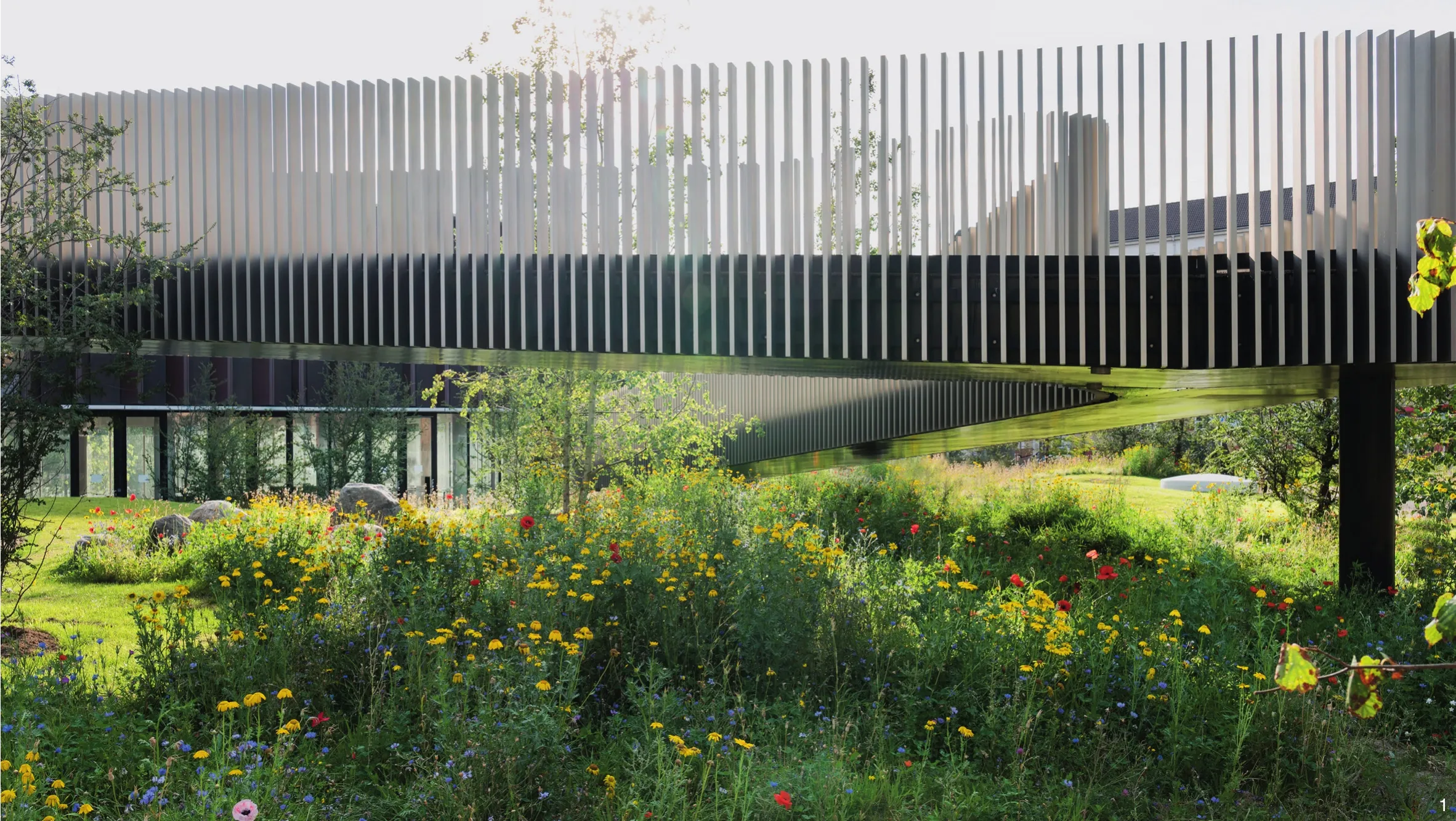
1 哥本哈根大学Panum研究中心“SUND公园”SUND Nature Park
第3部分就是我们去尝试更多地定义新的自然和新的人类关系。说到我们怎么去定义新的自然和新的园林,从我们项目的物质性上其实做了很多的工作,我们用了2种仍然是自然的物质,第1个是松树,第2个是竹,它们不仅有自己的物质条件,还有中国文化。一个代表坚韧不拔,一个代表谦虚,除了文化上的意义以外,我们从另外一个方面去看新的人类世,例如混凝土的重新利用、可持续利用,这样的一些关键词去看待新的人类世里我们怎么去定义在这样的环境下,人和自然的关系中的新的物质。我们希望强调的是,通过这样可持续的过程,我们以一种流动的态度看待这个社会和物质世界, 强调事件以及物质存在的过程性。它们都是在不断变化的,并不是一个结果而已(图10)。我们有一个1 200多m2的场地,对场地用一面石墙、三面竹墙进行围合。然后有一个曲形的竹桥穿过整个场地,对于我们的设计来说,你并不是走入这个花园,而是越过这个花园,在这个花园里有一个大的假山石,但是我们并没有完全去追求中国古典园林里的形式,我们其实是希望用混凝土再利用的方式去展现现在人类社会机械化意义的传达,当然我们希望把混凝土重新利用,在一个可以3D打印的机器里,假山其实并不是传统意义上的假山,而是去追求一个机器的运动和再利用的质感。同时我们还创造了风和雾以及味道这样一些关键词去象征中国古典绘画里的留白,意境和感知。
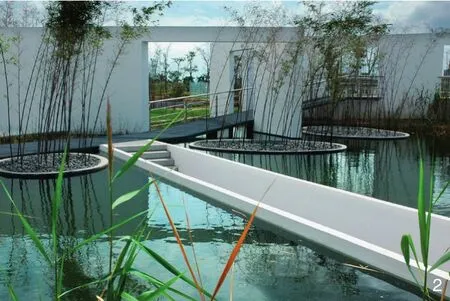
2 厦门园博会“竹园”“Bamboo Garden” in Xiamen Expo

3 西安世界园艺博览会“四盒园”“Four Boxes Garden” in Xi’an Expo
LA:在本次世园会“绿色生活,美丽家园”的主题背景下,王教授,您对城市与自然的关系这一话题有何新的思考?
WANG:城市总是在变化和发展的,尤其是对中国这样的国家,在目前城市化进程非常迅速的时期,城市的扩张非常迅速,城市和自然的关系也一直在改变,但是无论怎样变化,让一个城市具有良好的宜居环境,这个城市内外的自然系统必须是完整和连贯的,就像中国历史上的许多城市一样,不管这个城市是大是小,人口是多是少,城市的地理位置是南是北,海拔是高还是低,城市的内部和外部必须都具有一个完整连贯的自然系统。
LA:我们在SLA的许多项目中,比如Anchor Park in Malmö中,感受到了多样的设计手法、多种元素的巧妙运用带来的艺术冲击力,而在王向荣教授的江洋畈生态公园设计中,感受到的是一种更加平和、自然的氛围。对于风景园林中的艺术和生态、人工美和自然美之间的关系,2位是如何理解和平衡的呢?
Stig:从“二战”之后,因为战争的原因,欧洲国家开始重新建立自己的社会和城市,在这个过程中其实它们关注的是如何以非常快速以及理性化的方式把这个国家重新建立起来,效率是他们关注的重点。对于我来说,这些欧洲国家在这样一个过程中失去了对自然美的感受,于是在之后的城市建设过程和设计中,我们也希望可以逐渐把这样一个感受慢慢找回来。而且现在更多的人越来越多地能感受到效率带来的城市空间与人之间的疏离感。越来越多的人希望自然环境是在城市之中(图11)。
WANG:我理解的景观landscape有多重的含义和综合的意义。景观具有历史、社会、文化、生态、艺术等多方面的价值。我们追求的是景观的各种属性的平衡,不会为了功能而忽视场地的历史,为了生态而忽视艺术,为了自然而忽视人的需要。我们希望自己的设计与今天的生活相关,具有艺术的品质,汲取了历史的精神、符合生态的原则、反映了社会的需要和技术的发展。
LA:我们都知道,2位十分关注风景园林的乡土性或地域性,并且都接触过一些国际项目。在这些国际项目中,2位在理解和阐释陌生文化语境下的景观地域性时,是否遇到过困难?又是如何应对的呢?尤其是对于安德森教授,您在中国的设计项目过程中是如何处理景观的地域性问题的?
Stig:我们公司的设计和文化有独特鲜明的特质,但是这并不代表我们公司的地域性成为了一种局限。我们公司主要平时交流语言是英语,我们的项目遍布全球,而且我们在国际上的声誉和项目也在不断扩张,比如中东、法国以及一些北欧地区的项目。我们在与其他文化交流的过程中,面对着不同文化、不同行业的人,工作的时候当然会有一些挑战,但是我们相互之间理解而且相互之间去试图理解文化差异和工作方式,去包容和理解差异,其实不仅是作为一个景观设计师,也是作为一个人对自己更高的要求。
WANG:我觉得对于一个训练有素的设计师来说这并不是问题。在全球化的今天,大家的交流非常密切,互相了解的渠道和方式也非常多。设计师不可能只做当地的项目,设计师的工作方法就是用眼睛去观察世界,用心去体验世界,再通过各种各样的手段来了解和研究这个世界,还可以与当地的人进行合作。对我来说,并没有因为不同地点文化的差异而带来设计的困惑和难题。
LA:据我所知,丹麦是世界上幸福指数最高的国家之一。相比起丹麦,中国的幸福指数就没有那么高。幸福指数的评判指标包括GDP、国民健康状况、预期寿命、社会支持程度等方面。在幸福指数差异极大的2个国家和社会背景中,风景园林的使命和关注点有何异同?
Stig:确实有的时候在讲到幸福指数时,可能丹麦数值上挺高的,但我认为,快乐这种东西是挺难量化,因为你偏要给它一个数字的话,意味着它需要是一个非常理性而且可控制的。除了可以量化的部分以外,其实还有一部分就是你作为居民、市民的个人感受,我觉得要去比较这个感受的时候,说不定亚洲国家像是中国甚至会比欧洲国家或者丹麦这样的国家要高。
WANG:正像Stig说的,百姓的幸福指数确确实实很难量化。对风景园林师来说,我个人感到在中国可能幸福指数更高,为什么呢,因为在中国你有更多的机会、更多的可能做更广泛的研究,完成更综合更复杂的实践。因为2个国家的发展阶段是不一样的,丹麦的城市化率已经达到了百分之九十几,中国的城市化率还不到60%。未来一段时间,中国的城市化率每年还要增加1个百分点以上,这意味每年都有1 000多万的人从农村进入城市,中国还有巨大的建设量,这为风景园林师提供了无限的机会。另外过去30年中国在迅速发展的同时,对环境也有极大的破坏,风景园林师有无限的机会去修复这些环境。在中国,风景园林师具有更光明的前景,所以比较两国的风景园林师,中国的风景园林师的幸福感应该更高,因为他们有更多的机会。

4 新加坡花园节“心灵的花园”“Garden of Hearts” in the Singapore Garden Festival
LA:王向荣教授在北林已经任教31年,安德森教授也是丹麦哥本哈根大学的教授,2位作为风景园林专业的教授,你们最希望传授给同学们的是什么?对于这些未来的风景园林师们有怎样的期许?
Stig:我认为就像之前说的,当新的环境可能需要去重新定义新的自然关系的时候,其实就是未来的景观设计师需要去学会应对这样的事情。现在已经不是一个景观设计师能独当一面的时候了,就像SLA一样,我觉得未来的风景设计师或者说现在开始其实就应该学着要去跟更多不同的专业合作,比如说我们公司有人类学家、 生态学家、土壤学和城市方面的专家,我们所面临的未来, 需要我们去学会合作。更重要的是,在这样合作之中你要知道你自己能贡献一些什么样的视角,或者说力量和能力。同时我认为,景观设计师其实是能在这样的项目以及团队里起到管理和协调的作用,引导以及架构整个设计, 甚至需要我们架构整个结构、整个项目方向的一个工作职责。所以现在的学生也需要更多地去注意这样一些工作性质的变化,这也是他们需要学习的(图12)。
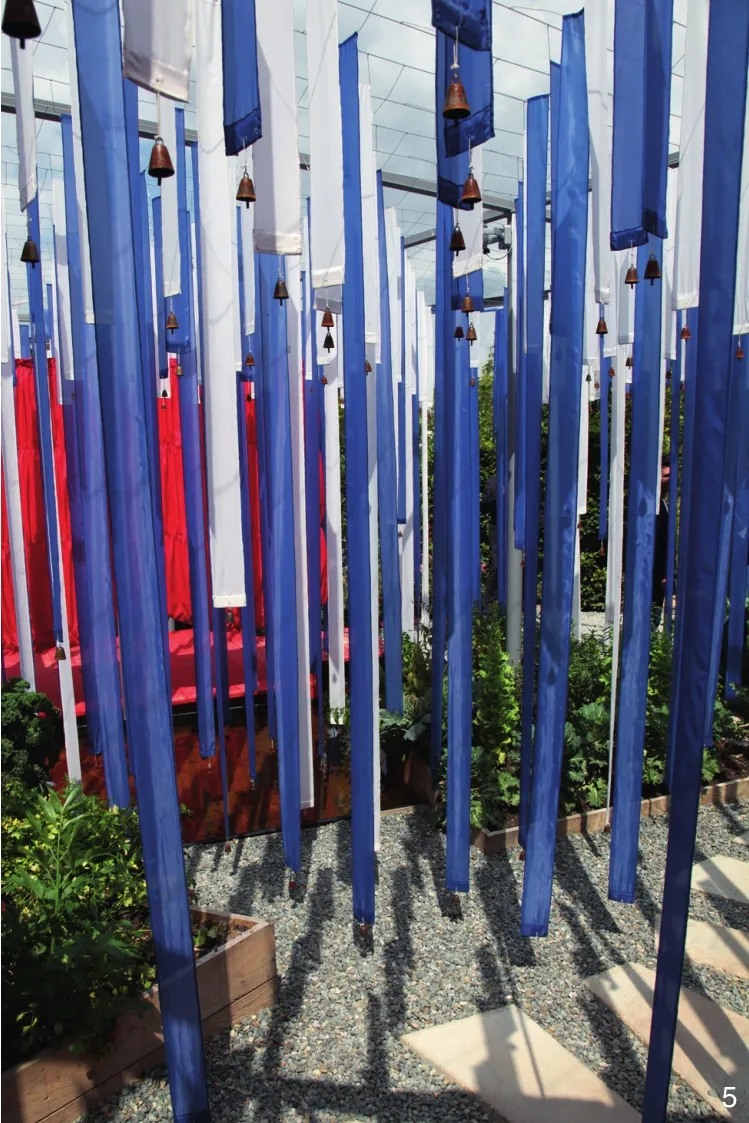
5 法国肖蒙花园节“天地之间”花园“Between Sky and Earth” in the International Garden Festival at Chaumont sur-Loire
WANG:应该让学生知道他未来的工作是非常重要、非常有意义的。他们的工作将涉及人类的整个生存系统和生活环境。第二也要告诉学生,只有付出艰辛努力,才有可能取得很好的成绩。第三是要全面发展,风景园林研究和实践的范围是非常广泛的,只有更全面的发展,才有可能在未来做出更有价值的工作。
LA:最后,请2位谈一谈对于2019北京世园会的期望或寄语?
Stig:其实这一次我们的目的是希望在新自然关系下展现出更多的可能性,以及想要挖掘出新的自然关系下的美,我们不希望人作为社会的一部分仅仅是被我们所造的环境所影响,也希望我们能成为其中非常融洽且和谐共处的一部分,我们也能体验到美的存在(图13)。
WANG:我的希望有3个,第一是这个世园会任何的展览都与百姓的生活密切相关,成为百姓生活的一部分,而不是仅仅是一个展览。第二就是更多地展示我们这个行业的新的思想、新的方法、新的工艺、新材料、新技术和新的可能,而不是像以前很多的园林博览会那样多是重复以往的成就和经验。第三希望这个展览是把一个原本一般的场地环境变成一个更美好的环境,而不是把一个美的环境变成平庸。
致谢:感谢张博雅前期准备采访内容。
注释:
图片1、6、7、9~13由SLA提供;图片2~5、8由北京多义景观规划设计事务所提供。
录音整理:钟丽君 许志诚
翻译:万静柯
校对:王晞月
(编辑/张雯娟)
The famous Danish landscape designer Stig L. Andersson is the founder and Creative Director of SLA, and he is also the visiting professor at the University of Copenhagen in Denmark. His projects include landscape architecture and city design. Professor WANG Xiangrong, the dean of the School of Landscape Architecture at Beijing Forestry University and chief editor of this Journal, has been working on teaching, researching and planning design and practice in landscape architecture, and his works have won many important awards home and abroad.
Professor ZHANG Jinshi, the contributing editor of this Journal, invited these two celebrities abovementioned. With the chance of Beijing Expo 2019,they have deep conversation in terms of these topics and issues including design philosophy, city and nature,nationality and locality and art and ecology as well as expectations of future expectations.
LA: Let’s start from the creative garden. As we know that both of you have designed Master Garden or Creative Garden in the Horticultural Expos. Professor WANG has designed the“Bamboo Garden” in Xiamen Expo, “Four Boxes Garden” in Xi’an Expo, “Garden of Hearts” in the Singapore Garden Festival, etc. As for Professor Anderson, you have designed the “Mud Garden”in Xi’an Expo, and also have designed several small gardens in different cities, such as the Charlotte Garden. Do you both regard (the design schemes of) these small gardens as a kind of extraction of design concept trying to convey unique design philosophy?
Stig: I think that re-guiding the garden is so interesting how you can express your feelings. So,basically what I learn from China, Chinese culture is the garden expression. It is an extension of what is inside you into a physical expression as we think of design.So this is what interesting me re-guiding more garden protect. It is relationship between how do you feel, and the meeting of the new nature is a science nature (Fig. 1).
WANG: The exhibition garden is very (a special type of gardens) special, and the purpose of my design is mainly to make people who enter my garden (can) feel mystery so that they can ponder and imagine here, and meanwhile in this way it can create a feeling of boundlessness although (in spite of) it is very small. In addition, people can enjoy the unique painting and poetic feeling of classical Chinese garden (Fig. 2-5).
LA: The use of plants is emphasized in the design of Creative Garden in the coming Beijing Expo 2019. In previous projects, such as Jiangyangfan Eco-Park (designed) by Professor WANG and the exhibition of “The City of a Billion Pines” designed by SLA and held at Danish Cultural Center, Beijing, both of you showed the respect for plants and the outstanding skills of planting design.According to your practical experience, what kind of effects does the use of plants may have on the design scheme. Can you share some experience with us from the aspect of handling plants, this kind of natural design element?

6 北京798 “松临城下”The City of a Billion Pines
Stig: When I took the exhibition in 798 Art District last year, The City of a Billion Pines, the idea was to focus on the aim that was to make people in cities focus on the important of having growing environment (Fig. 6), especially in China, but all over the world, the cities are growing very fast. It means that it will be more and more buildings environment and less less nature. So I think we have to explain why it’s important to have growing environment in order to create a better life condition for people.And I think pine tree especially in China, because of the culture reason, is a very strong tree to use it the sense because it both awakes emotional feelings what I called it take the sense of nature, but also has utility value that it can clean the air, so we can have less smoke in the city (Fig. 7).
WANG: I completely agree with what Stig said just now, the expansion of urban has made the natural landscape become less and less, so people should care more about plants in order to well balance the nature and human. As a landscape architect, how to utilize plants is a very important issue and I think every landscape architect has their principles. On this basis,it is of great importance that plants can create habitat environment for all creatures. We know people live in cities and they are the most important ones, but there are many other living things existing here. For landscape architects, plants not only create beautiful environment providing various services for human’s healthy life, but also provide habitats for other creatures. Here it refers to the Jiangyangfan Eco-Park which is a wild field in the city. And our design is to protect the successional procession of plants in this place (Fig. 8). I think most plants in cities are now under human’s control and such plants couldn’t provide habitats for other creatures. Cities should and must leave some space for vegetation communities to grow and succeed according to their own laws so as to create living conditions for other living things, which is to create the possibility of biodiversity for cities.
LA: The following question is specifically for Professor Anderson. What is the design concept of your project in the coming Beijing Expo 2019? And what is the difference between it and your previous projeces?
Stig: I think it is an interesting fact that the nature today the relationship between man and nature today is not as same as in old time, like in Song Dynasty and for western country like Renaissance or before it. Today we are facing a new situation. Well, nature is not something with outside.Today, nature and culture is not separated anymore.It is same because our impacts on nature have been very strong, so the nature we today face is thought of a new nature that we are cooperating of, the quality, at the Anthropocene that means we have to rethink our relationship between man and nature.
So, if you are looking at the traditional culture which is the first step the man cultivates the earth, it was done to use the resources from having food, making fire, so you can prepare food and have long live together, so people are gathering around the fire. For that stage, this is thirty thousand years ago. After the ice time,man began to rejoin himself from nature (Fig. 9).So, that was first step, in our act of its feeling so to say the geological system of the earth. Next step was to develope its traditional Chinese garden, well beauty will come into it.
And third step, it was I suppose it’s a new Chinese garden. All the materials in the garden the way we treated, it’s both arti ficial and natural growing so it’s to say, so we are interfering all the nature processes in the way we express the garden. All nature material used is bamboo and pine. Pine as free in the way growing tree,which is very strong, this is also the meaning in Chinese culture, and bamboo which is the modesty. The other material like concrete, scaffolding which is surrounding the garden as a wall is material that we borrow from already sixteen billion constructions. So the whole garden is composed of material that after exhibition can be used. This is a process where the garden is a sort of circular economy, as nothing would stand forever,everything is in the process, and now we are in the fact that is a man-made cooperation of a new natural expression (Fig. 10). We have a site that is one thousand three hundred square meter, and we are making it closer like a garden, and we have bridge that is an urge so you walk over. So you are not walking into the garden, you are walking in the out of the garden. So we have a cliff like a traditional garden, but this cliff is made of reused concrete. That concrete is from demolished buildings,putting into a machine that build up a sort of a cliff but it is an arti ficial one, and also the shape is not like the cliff, but it is resided of the power machine works. And there are some nests in this cliff where the pine tree can rest. On the other side, we are creating wind by having a fan, and water with reused rain water. So you walking to mist, so what is the emptiness in the traditional Chinese painting? I change to an atmosphere of the same emptiness but created by modern technology.
LA: With the theme of “Live Green, Live Better” in this Beijing Expo 2019, Professor WANG what’s your new idea on the topic of the relationship between city and nature?
WANG: Cities are always changing and developing, especially for countries like China. In the current period of fast urbanization, cities have expanded rapidly and the relation between city and nature has been changing all the time. However, no matter how it changes, only a complete and coherent natural system inside and outside, can the city have good livable environment. Just like the cities in Chinese history, regardless of the scale, population,the geographical locations and altitudes, they must have a complete and coherent natural system.
LA: From many of SLA’s projects, such as Anchor Park in Malmö, we can feel the artistic impact by various design techniques and ingenious use of various elements. But in the design of Jiangyangfan Eco-Park by Professor WANG Xiangrong, we can feel a more peaceful and natural atmosphere. How do you both understand and balance the relationship between art and ecology, artificial beauty and natural beauty in landscape architecture?
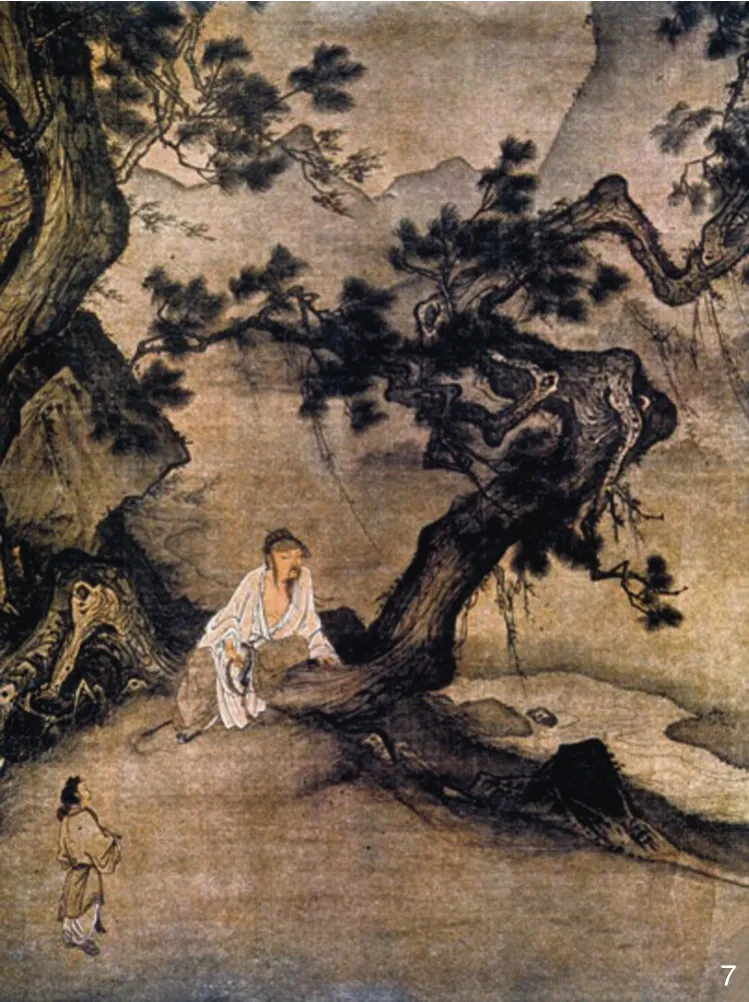
7 南宋马麟 《静听松风》Listening to the Wind Under a Pine Tree, MA Lin, South Song Dynasty

8 杭州江洋畈生态公园Jiangyangfan Eco-Park, Hangzhou
Stig: I think we are through modernity which developed very fast after the second world war. We forgot the meaning of what beauty is. So we were thinking most countries all over the world must think of the rationality in surviving so to say and build up a new society. So all countries that go into a modernization are mainly thinking of the rational out put of that and that have the fate that they are appreciations of the beauty and the man-solationship to match natural process and phenomenon in nature is under priority.So it is becoming less important, and I think that we can use the thinking in other philosophy and landscape architecture to bring into use. The importance of its deepest sense of nature which is actually those tree together and appreciated the beauty that we are embraced by when we meet natural phenomenon. And more and more people all over the world are aware of that according to the very fast development (Fig. 11).
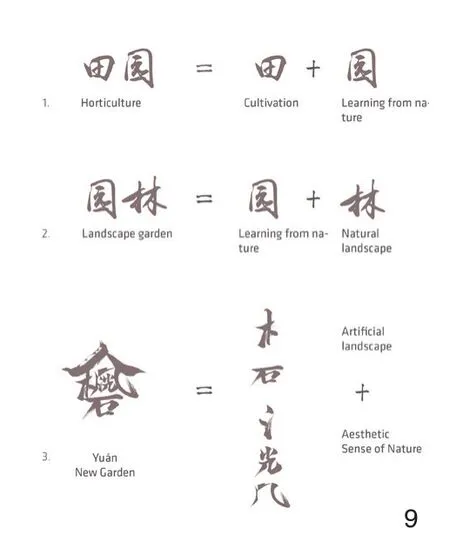
9 2019北京世园会“Yuán”概念分析图‘Yuán’ Conceptual Diagram, Beijing Expo 2019
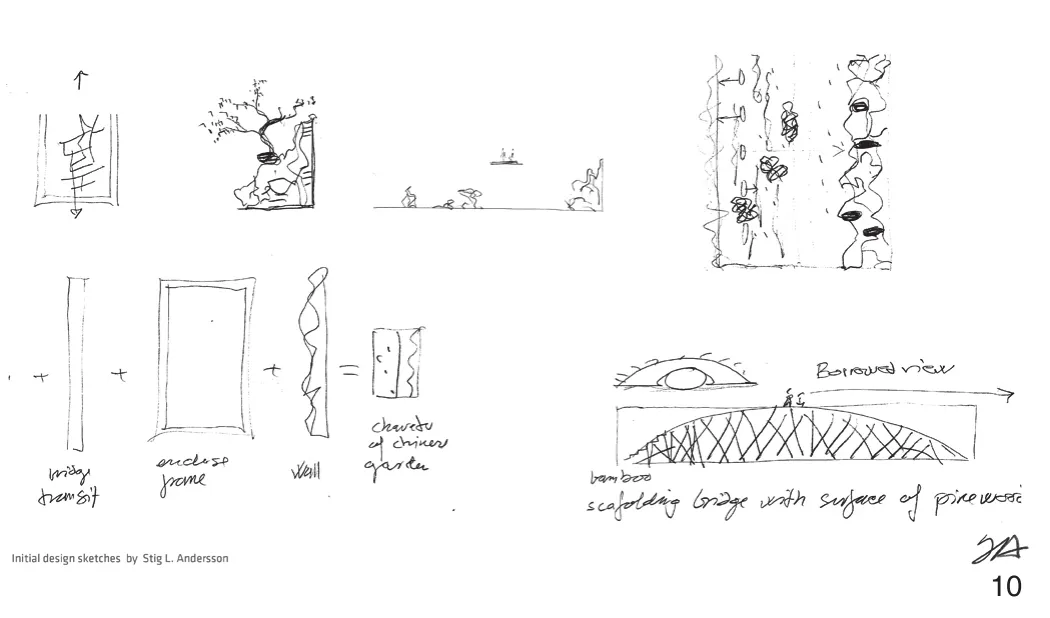
10 2019北京世园会“Yuán”斯蒂格·L·安德森手稿‘Yuán’ sketches of Stig L. Andersson, Beijing Expo 2019

11 SEB银行“城市山丘”The City Dune - SEB Bank
WANG: The landscape, in my opinion, has multiple meanings and comprehensive significance.It has various values in many aspects such as history,social, culture, ecology and art. What we pursue is the balance in all attributes of landscape, and we will not neglect history of cities for the sake of their functions,neglect its artistic value for ecology and neglect human’s needs for the nature. We hope that our design can have close relationship with our current life, possessing the artistic quality, drawing on the spirit of history,conforming to the ecological principles and re flecting the social demand and technological development.
LA: As we all know that both of you are very concerned about the vernacular character or regional feature of landscape architecture,and also have engaged in some international projects. In these projects, have you been in troubles in expressing landscape territoriality with unfamiliar cultural context? Especially for professor Anderson, how do you deal with the landscape territoriality in your design projects in China?
Stig: I don’t think that the way I or my office work is limited to original thinking. We are working all over the world, so we meet many different countries.In the office we are many different countries. The main language is English, even though our of fice is in Copenhagen. We also have offices in Oslo Norway.Well, it’s different country. We are working in the Middle East, we are working in China, we are working in many places, in French. So we are meeting many countries, many different countries. Of course that causes some challenges and these challenges can be solved in a common way. So it’s about the conversation.It’s about the dialog understanding the respects for the country we meet and when you do that, you also have respected yourself from the people you work together.And I think that raised quality both of the landscape architecture but also the human beings.
WANG: I think it is not a problem for a welltrained designer. Along with the globalization,their exchange has become closer and they have multiple channels to understand each other. So it is impossible for designers to only carry out local projects. Their working methods are to observe the world with eyes, experience it with heart,understand and study it through various means, and cooperate with local people. And for me, cultural differences in different places don’t bring me the designing confusion and dif ficulties.
LA: As I know, Denmark is one of the countries with the highest happiness index in the world. Compared to Denmark, China’s happiness index is not that high. The judgment of happiness index includes GDP, national health status, life expectancy, social support and so on. What are the similarities and differences in the mission and focus of landscape architecture between the two countries with great differences in happiness index and social contexts?
Stig: I know that Denmark usually called it having the highest index happiness, but the interesting is how is that measured? Because it’s related to something you can measure, which means you could put numbers on it. But I think landscape architecture is about the feelings, is how you feel, you can not put numbers on how you feel. So it’s half of the solution I think that only looking happiness that something you can measure, you also need the other half which is how do you feel, and I think if you look at both those two paradises, as understanding what happiness is. Then maybe China have bene fited of what do you feel. The relationship between man and nature is probably much its out of eyeexperiences, much stronger in the Asian countries than its in Denmark and western countries. So if we do happiness index on how do we feel, maybe it will down fade and then Asian country will win.

12 SLA哥本哈根办公室一角SLA Copenhagen Office
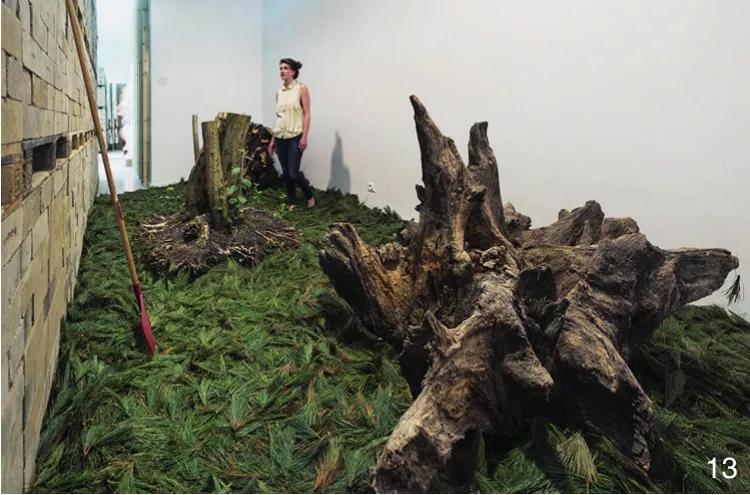
13 威尼斯建筑双年展“Empowerment of Aesthetics”Venice Architecture Biennale 2014: Empowerment of Aesthetics
WANG: As Stig said, people’s happiness index is indeed difficult to quantify. For landscape architects,I personally feel that there may be a higher index in China, because here you have more opportunities and possibilities to do more extensive researches and complete more comprehensive and complex practices.The development stages of the two countries are different, and the urbanization in Danmark has achieved more than 90% while that in China has been less than 60%. For some time to come, the urbanization in China will increase more than one percentage point each year,which means more than ten million people will enter cities from rural areas every year. The huge amount of construction in China provides opportunities for landscape architects. In addition, in the past 30 years,China has developed rapidly and the environment has been destroyed greatly, thus landscape architects have in finite opportunities to restore it. In China, landscape architects have a bright future, so comparing architects in the two countries, those in China should be happier for they have more opportunities.
LA: Professor WANG has been teaching in BFU for 31 years, and Mr. Anderson is a professor in the University of Copenhagen. What do you want to impart to your students mostly?What expectations do you have for those future landscape architects?
Stig: Since we are facing the situation where nature has changed to a new nature that we are cooperating of. We have such a big impact on our environment today. It’s important to have many cooperators to work together, like biologists, gardeners,landscape artists, philosophers, engineers, so lots of different cooperators and professions have to work in team, to solve, to form the process of a new landscape architecture. So we need a new approach to landscape architecture, and I think the most important part of that is to understanding what it’s your contributions,compared to other cooperators, and then being able to managing this kind of team work. And I think the landscape artists have an important road. So it’s what I am teaching to my students (Fig. 12).
WANG: Firstly, it is very important and meaningful to let students know more about their future job which will concern human’s whole survival system and living environment. Secondly, we should tell them only by hard working can they make good results. Thirdly, they should develop in an all-round way. The researches and practices about landscape architecture are very extensive, so only with all-round development can they present more valuable work.
LA: Finally, could you please talk about your expectations or wishes about the Beijing Expo 2019?
Stig: I think the most important part is to give the visitors possibility to see the beauty in the new nature,that is what I call the deepest sense of nature. This is when you really feel something deep inside you. When you sense your environment, and it gives you a deep feeling that you feel pleasant. And you do that to get joy expression which we are cooperating of and not just a philosophy that is think insist our part. But today, it’s fact that we are also the one treated condition for heavy rain or storms and see not only a threaten but also to be able to see the beauty. So my aim of this project is to give people the opportunity to see that is all the beauty in the new situation and that always a threat (Fig. 13).
WANG: I have three hopes. Firstly, I hope that every exhibition of the Beijing Expo 2019 should have a close relation with people’s life, even become a part of people’ life, instead of a simple exhibition. Secondly, I hope it can show more new ideas, methods, techniques, materials, technologies and possibilities of our industry, instead of repeating the past achievements and experience in the previous horticultural expos. Thirdly, I hope this expo can change the ordinary site into a beautiful environment,instead of changing beauty into mediocrity.
Acknowledgement:Thank ZHANG Boya for her contribution to this interview during early preparation period.
Notes:
Fig. 1,6,7,9~13 are provided by SLA, Fig. 2-5,8 are provided by Atelier DYJG.

